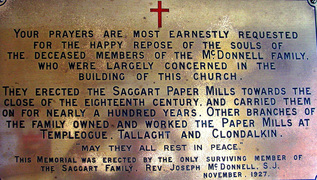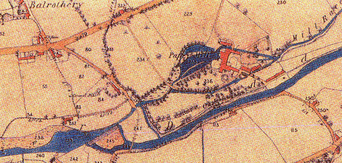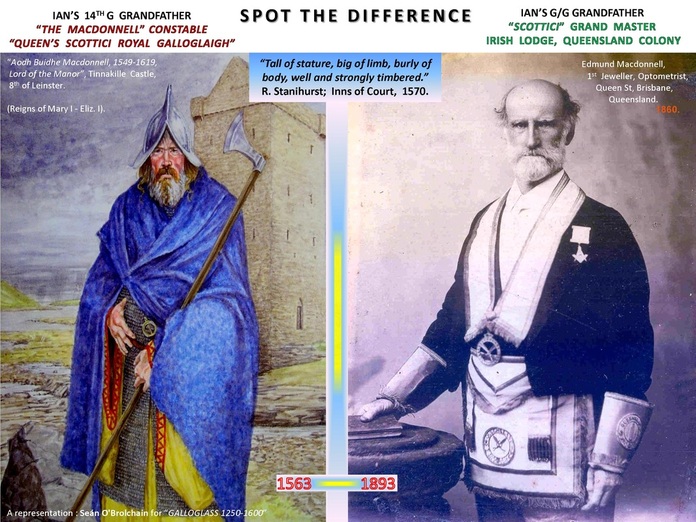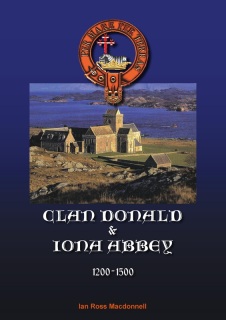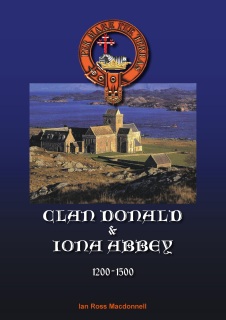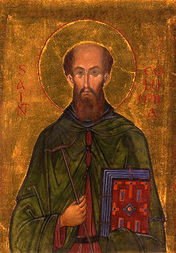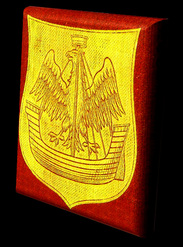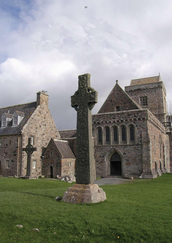The book has been six years in the making and started with a trip to see Angus Og's graveslab. (One of six trips I have made to Scotland, Ireland, London). I just wanted to see the embryonic clan name MAC • DOMNILL • incised in stone.... 700 years old. And of course to experience the internationally famous island of Hi.... "A gem in the ocean.... the light of the western world".
The slab wasn't in St Oran's Chapel (rightfully with the others) and it couldn't be located by signage. It was not attributed to anyone. I had to know why.
I had no preconceived ideas or views about Iona Abbey and Clan Donald.
They slowly developed as I made further research into Grave-slab No. 150. Doreen Grove, Head of Cultural Services and past Principal Inspector of Ancient Monuments, Historic Scotland has been most helpful. She, and Lisa Graham, advised me that the Royal Commission (RCAHMS) had decided slab No. 150 did not belong to Angus Og - but a nebulous non-entity, a postulated Angus, son of Angus Master of The Isles (200 years after Angus Og). RCAHMS and Historic Scotland are now merging.
The research was later assembled into a Tour Guide for a Clan Donald High Chief's Tour in June 2011, which I led. A service was held in the Michael Chapel, most kindly arranged and led by Murdoch MacKenzie (The Iona Community leader, Reverend Peter MacDonald was on leave). The Iona Abbey site manager, Jane Martin of Historic Scotland, has always been of great assistance.
The guide then had to develop fairly quickly for a Clan Donald submission to the Historic Scotland and Iona Community Research Conference (Interpretation of Iona) in April 2012.
The book's main messages are also being delivered at Clan Donald AGM's and conferences around the world. USA led the way with Louise Coughlin McDonald making a well received presentation at the San Francisco AGM in September 2012. The Australia and New Zealand ["ANZAC"] conference in Auckland is the next venue for a major presentation in Feb 2013. Smaller meetings have had the issues explained and discussed.
The submission has been improved for a 2nd Ed. (book) to be published early Jan 2013.
This site derives from the book which has the main body complete. Five chapters, out of nine, on extra detail of individual Kings/Lords of Isles still in draft. However, they are well covered throughout where necessary in the main body.
Clan Donald and Iona Abbey 1200-1500 - National Library of Australia
[ProtectRite Registration #: R692-16....]
The slab wasn't in St Oran's Chapel (rightfully with the others) and it couldn't be located by signage. It was not attributed to anyone. I had to know why.
I had no preconceived ideas or views about Iona Abbey and Clan Donald.
They slowly developed as I made further research into Grave-slab No. 150. Doreen Grove, Head of Cultural Services and past Principal Inspector of Ancient Monuments, Historic Scotland has been most helpful. She, and Lisa Graham, advised me that the Royal Commission (RCAHMS) had decided slab No. 150 did not belong to Angus Og - but a nebulous non-entity, a postulated Angus, son of Angus Master of The Isles (200 years after Angus Og). RCAHMS and Historic Scotland are now merging.
The research was later assembled into a Tour Guide for a Clan Donald High Chief's Tour in June 2011, which I led. A service was held in the Michael Chapel, most kindly arranged and led by Murdoch MacKenzie (The Iona Community leader, Reverend Peter MacDonald was on leave). The Iona Abbey site manager, Jane Martin of Historic Scotland, has always been of great assistance.
The guide then had to develop fairly quickly for a Clan Donald submission to the Historic Scotland and Iona Community Research Conference (Interpretation of Iona) in April 2012.
The book's main messages are also being delivered at Clan Donald AGM's and conferences around the world. USA led the way with Louise Coughlin McDonald making a well received presentation at the San Francisco AGM in September 2012. The Australia and New Zealand ["ANZAC"] conference in Auckland is the next venue for a major presentation in Feb 2013. Smaller meetings have had the issues explained and discussed.
The submission has been improved for a 2nd Ed. (book) to be published early Jan 2013.
This site derives from the book which has the main body complete. Five chapters, out of nine, on extra detail of individual Kings/Lords of Isles still in draft. However, they are well covered throughout where necessary in the main body.
Clan Donald and Iona Abbey 1200-1500 - National Library of Australia
[ProtectRite Registration #: R692-16....]
|
MACDONNELLS OF THE SAGGART, TEMPLEOGUE, TALLAGHT AND CLONDALKIN PAPERMILLS WERE GENEROUS PATRONS, MAJOR BENEFACTORS, AND "LARGELY CONCERNED IN THE BUILDING OF" THE SAGGART PARISH CHURCH (AND VILLAGE) IN THE 1830’s, WITH SEXPARTITE VAULTED CEILING AND ST COLUMBA STAINED GLASS WINDOW.
FAMILY ORIGINS. FROM THE 3RD CHIEF OF CLAN DONALD, ALAXANDAIR OG, k.1299, A SENIOR LINE OF CLAN DONALD AND FOUNDER OF THE "ECCLESIASTICAL MACALLISTER NOBLEMEN", ABBOTS OF IONA AND SADDELL. THE "ROYAL SCOTTICI" GALLOGLAIGH CONSTABLE MACDONNELLS OF LEINSTER - "OF THE PALE", BALLYDONNELL, RAHEENDONNELL & TINNAKILL CASTLE, ETC, c.1450-1650. THE CLAN DONNELL GALLOGLAIGH BEGAN THE QUEST TO EXTRICATE IRELAND FROM NORMAN INVASION FROM THE MIDDLE OF THE 13TH CENTURY AND WERE THE “DECISIVE MILITARY COMPONENT IN THE GAELIC IRISH RESURGENCE AND THE CUTTING EDGE OF RESISTANCE TO TUDOR RECONQUEST TWO CENTURIES LATER” [1]. IT CAN BE WORN AS A BADGE OF HONOUR THAT SIR HENRY BAGENAL IN 1592 BLAMED THE GALLOGLAIGH FOR BEING “THE FIREBRAND AND NURSE OF REBELLION”. STATE PAPERS REPORT “THE CLANDONNELL GALLIGLASSES, A NAUGHTY RACE AND PRONE TO REBELLION”.[2] |
SWAPPING CHAINMAIL ARMOUR FOR CHAINWIRE PAPER MOULDS, THEY BECAME THE LARGE "MACDONNELL DYNASTY" OF MASTER PAPERMAKERS, PRINTERS AND BOOKSELLERS OF DUBLIN COUNTY, 1750-1900 (10 MILLS NEAR "CLANN DONNELL'S COUNTRIE" OF OLD, WICKLOW FOOTHILLS - "Galloglass of the Mountain").
"South of Dublin the Wicklow Hills rear their neat naked summits to the rain. On their lower slopes three folds of ancient Silurian strata catch headlong streams damming them into pools, long, deep and sandymouthed, as perfect filtering beds as nature ever devised. Better water for washing linen one could not wish for — linen for a lady's back or for the "breaking in", it makes no odds. In the early sixteen hundreds they made paper here, samples of which extant today prove its whiteness, texture and uniformity." OUR LINE OWNED THE "BELLA VISTA", TEMPLEOGUE MILL [3] BEFORE INTEGRATING INTO LETTER-PRESS PRINTING AT 13 ANGLESEA ST, TEMPLE BAR, DUBLIN (1830's). ________________________ [1] Galloglass; Marsden. [2] ”Description of Ireland Anno 1598”; Hogan; 1878. p.85. [3] 'Bella Vista' mill; OS Map c. 1830. |
JAMES MACDONNELL, 10th of LEINSTER, d.1661, London. Patent from King Charles I, 1637 as :- LORD OF THE MANOR AND CASTLE OF TIGH NA COILLE — TINNAKILL, QUEENS COUNTY: “Its castellans of old derived from an illustrious and chivalrous race - whose Chiefs were styled 'Lords of the Isles'".
ABOUT ME :-
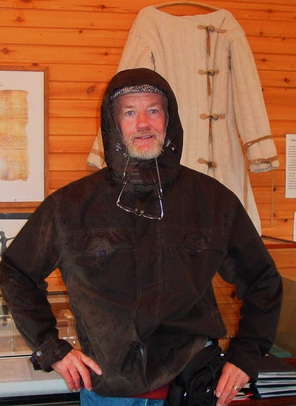
I have a decades long background in Corporate Services (Asst Director of Property, Finance, Recruitment, Training, etc) and have formal qualifications in Macro-Economics (Post-Grad, QUT) and Art History, Applied Photography-Graphics (QCA).
I have many “hands-on” building and cabinetry skills which have been applied fastidiously to antique furniture and period house restoration involving detailed “architectural archaeology” and integrating historical research. I am a member of the National Trust and have been in Air Sea Rescue, Moreton Bay, and National Service 1966-69.
The 1885 staircase below was so badly damaged with a third of its balusters ripped out by tenants, treads and risers coming away from stringers, a bathroom and cupboard shoved underneath and so fouled with layers of paint all over that it could not be conserved [faux "oak wood graining" replaced by staining and french polishing].
I have many “hands-on” building and cabinetry skills which have been applied fastidiously to antique furniture and period house restoration involving detailed “architectural archaeology” and integrating historical research. I am a member of the National Trust and have been in Air Sea Rescue, Moreton Bay, and National Service 1966-69.
The 1885 staircase below was so badly damaged with a third of its balusters ripped out by tenants, treads and risers coming away from stringers, a bathroom and cupboard shoved underneath and so fouled with layers of paint all over that it could not be conserved [faux "oak wood graining" replaced by staining and french polishing].
